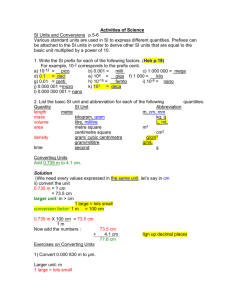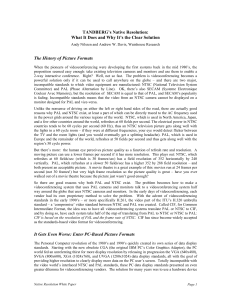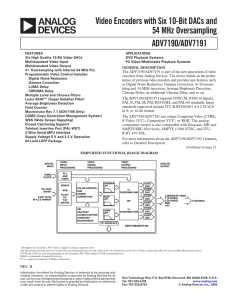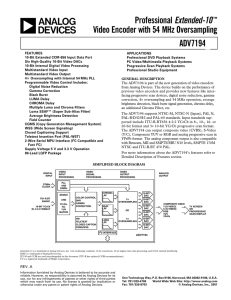Introduction to Video
advertisement
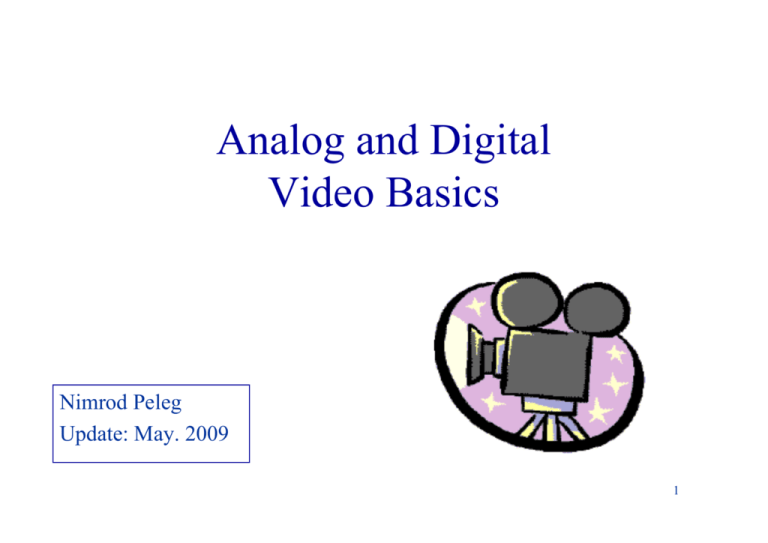
Analog and Digital Video Basics Nimrod Peleg Update: May. 2009 1 Video Compression: list of topics • • • • • • • • Analog and Digital Video Concepts Block-Based Motion Estimation Resolution Conversion H.261: A Standard for VideoConferencing MPEG-1: A Standard for CD-ROM Based App. MPEG-2 and HDTV: All Digital TV H.263: A Standard for VideoPhone MPEG-4: Content-Based Description 2 Analog Video Signal: Raster Scan 3 Odd and Even Scan Lines 4 Analog Video Signal: Image line 5 Analog Video Standards • All video standards are in • Almost any color can be reproduced by mixing the 3 additive primaries: R (red) , G (green) , B (blue) • 3 main different representations: – Composite – Component or S-Video (Y/C) 6 Composite Video 7 Component Analog Video • Each primary is considered as a separate monochromatic video signal • Basic presentation: R G B • Other RGB based: – – – – YIQ YCrCb YUV HSI To Color Spaces Demo 8 Composite Video Signal Encoding the Chrominance over Luminance into one signal (saving bandwidth): – NTSC (National TV System Committee) North America, Japan – PAL (Phased Alternation Line) Europe (Including Israel) – SECAM (Systeme Electronique Color Avec Memoire) France, Russia and more 9 Analog Standards Comparison NTSC Defined Scan Lines/Field Active horiz. lines Subcarrier Freq. Interlacing Aspect ratio 1952 525/262.5 480 3.58MHz 2:1 4:3 Horiz. Resol.(pel/line) 720 Frames/Sec 29.97 Component Color YUV PAL/SECAM 1960 625/312.5 576 4.43MHz 2:1 4:3 720 25 YCbCr 10 Analog Video Equipment • Cameras – Vidicon, Film, CCD) • Video Tapes (magnetic): – Betacam, VHS, SVHS, U-matic, 8mm .... • Optical Video Disk • Displays All for all video standards ! 19 First TV sets before 1935: "Mechanical Television Era". The display had a small motor with a spinning disc and a neon lamp, which worked together to give a blurry reddish-orange picture about half the size of a business card! 1939 - (GE-HM171) 5" tabletop, wood (mahogany), 3 channels, vision only - no sound ! From: http://www.tvhistory.tv/ 20 Digital Video • Developed with CD-ROM Technology • Brings computers and communication together in a truly revolutionary matter: – Personal computer – VideoPhone, FAX, HDTV, Live video (with processing), Local image printer, Video Conferencing, ...... 21 Digital Video Formats • For a number of years: professional TV studios used D1 (component) and D2 (composite) digital formats. • CCIR digitization (CCIR601) and interfacing (CCIR656) for digital video is base line for all formats, using component form known as 4:2:2 (Y, Cb, Cr). 22 CCIR Digitization • For component video signals (studio source) with BW=6MHz, CCIR sampling rate is 13.5MHz, independent of scanning standard • This rate represents 864 x Fh for 625 systems and 858 x Fh for 525 systems. • Active lines per frame is 720 for both. • For 8 bits/sample: 13.5M x 8 = 108M bit/sec. 23 Digital Video (CCIR 601) • Coded Signals: Y, Cb, Cr • Samples/line: 858 (NTSC) / 864 (PAL) - for color components: 429 / 432 • Active samples: 720 - for color components: 360 • Quantizer: Uniform PCM , 8 bit/sample (Y,Cb,Cr) • Gray levels Scale: 0 - 255 - Y: 220 Q levels (black:16, gray-white:235) - Cb,Cr: 225 Q levels (zero: 128) 25 Digital Video Signal • TrueColor: RGB , 24 bit (~16M colors) • Resolution: lack of sufficient resolution causes pixellation (blockization). • Synchronization: No need (“computer made”). • Conversion: A/D & D/A after cameras and before display (still too expensive). • The bottleneck: BITRATE 26 BitRates • CD Quality digital audio: 44.1KHz * 16bps *2 (stereo) = ~1.4Mbps • HDTV: about 1Gbps One picture worth (almost) a 1000 words... 27 Digital Video Resolution (CCIR601, 4:2:2) 525/60(NTSC) Active pel/line Lum (Y) Chroma(U,V) Active lines/pic Lum (Y) Chroma(U,V) Interlacing Rate/Aspect Ratio 625/50(PAL) CIF 720 360 720 360 360 180 480 480 2:1 60/4:3 576 576 2:1 50/4:3 288 144 1:1 30/4:3 28 Network protocols and Bitrates • Conventional telephone 0.3-56Kbps • ISDN 64-144Kbps • T-1 1.5Mbps • Ethernet (Packet based) 10M/100M bps • Broadband ISDN 100-200Mbps • ATM (Cell based) 155Mbps ….. • Fast Ethernet 1Gbps …. 29 Proprietary Video Formats • • • • • • DVI, Indeo QuickTime CD-I PhotoCD CDTV And many more…. Intel Apple Philips Eastman Kodak Commodore 31 Why Digital Video? • • • • • • • Quality Error correction Interactivity Computer control (s/w) Real-time playback and all kinds of editing Integration of many multimedia platforms And more ....... 32 A Summary of Video Formats • CCIR Size (D1) Progressive Pictures: – NTSC - 720x480 – PAL - 720x576 (29.97 Pictures/Sec) (25 Pictures/Sec) • CCIR Size (D1) Interlaced Pictures: – NTSC - 720x(240x2) – PAL - 720x(288x2) (29.97 Pictures/Sec) (25 Pictures/Sec) • HD1 (Half D1) Progressive Pictures: – NTSC – 352x480 – PAL – 352x576 (29.97 Pictures/Sec) (25 Pictures/Sec) • HD1 (Half D1) Interlaced Pictures: – NTSC – 352x(240x2) – PAL – 352x(288x2) (29.97 Pictures/Sec) (25 Pictures/Sec) 33 Video Formats (Cont’d) • SIF (Source Input Format) : – NTSC – 352x240 – PAL – 352x288 (29.97 Pictures/Sec) (25 Pictures/Sec) • QSIF : – NTSC – 176x112 – PAL – 176x144 (29.97 Pictures/Sec) (25 Pictures/Sec) • CIF (Common Intermediate Format) : – 352x288 (30 Pictures/Sec) • QCIF Size Pictures: – 176x144 (30 Pictures/Sec) 34 Video Chroma SubSampling 720 RGB 575 R G B 360 YUV 4:2:2 Y U V YUV 4:2:0 Y U V 288 YUV 4:1:1 Y U V 180 The basic line sampling rate of 3.375MHz is common to both PAL and NTSC TV systems 35 YCbCr 4:x:y Chroma Formats YCbCr 4:4:4 36 YCbCr 4:2:2 37 Color Decimation: 4:1:1 etc. Half color Bandwidth ! ! 38 Color Decimation Effect Luminance Chrominance Chrominance Restoration [Taken from: Wikipedia, “Chroma subsampling”] 39 Color decimation Artifacts: Moving text example Original, single field. The moving text has some motion blur applied to it. Original still image. 4:2:0 progressive sampling (single field) applied to moving interlaced material. the chroma leads and trails the moving text. 4:2:0 progressive sampling applied to a Still image. Both fields are shown. 4:2:0 interlaced sampling (single field) applied to moving interlaced material. 4:2:0 interlaced sampling applied to a still image. Both fields are shown. 40 Why ? In the 4:2:0 interlaced scheme, vertical resolution of the chroma is roughly halved since the chroma samples effectively describe an area 2 samples wide by 4 samples tall instead of 2X2. - As well, the spatial displacement between both fields can result in the appearance of block-like chroma artifacts. 41 Hebrew Literature: analog video • טלוויזיה בשחור-לבן ובצבע ,מט“ח 1982 - • אוניברסיטה פתוחה 42






